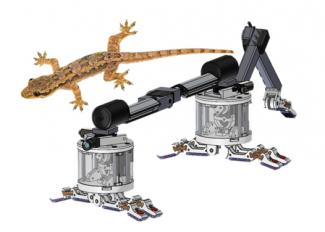In partnership with NETL, researchers from New Mexico State University and Arizona State University are taking cues from wildlife to create a new generation of autonomous robots to monitor and inspect vital energy and civil infrastructure.
Power plants, chemical plants, gas, oil and water distribution networks all contain critical tubular structures for fluid transport, heat transfer, and more. Depending on the application, the structures might be subjected to numerous extreme conditions or sustain defects such as corrosion, cracks and stress-corrosion cracks throughout their service lifetimes. Inspection and maintenance of these components is vital for sustained and reliable operation, but several problems for human-based inspection exist. These include hazards, such as high temperatures and hard-to-reach places, that make it difficult and dangerous for humans to effectively inspect these structures.
Robotics-based inspection can offer solutions because hazardous and/or hard-to-reach places can be examined without overhauling the unit, saving time and money.
With NETL support, the Intelligent Structures and Nondestructive Evaluation (ISNDE) Lab at New Mexico State University and the Bio-Inspired Robotics, Technology and Healthcare Lab (BIRTH Lab) at Arizona State University collaborated to pioneer a first-of-a-kind robot for inspecting tubular and pipeline structures.
The resulting design is a versatile, lizard-inspired tube inspector (LTI) robot with embedded non-contact ultrasound sensing that allows for crack and corrosion detection of components. The project represents an integration of couplant-free ultrasound sensing and transmission, advanced ultrasound imaging and a friction-based mechanical mobility component in the form of claw-like ‘grippers’ in a single robot. The technology is also capable of examining different types of surfaces with variable roughness and finishes as well as complex geometries.
“When looking for an optimal robot design integrating various nondestructive testing technologies, the answer was right there in front of us, courtesy of nature,” said Ehsan Dehghan-Niri, Ph.D., principal investigator of the project and an assistant professor of civil engineering at New Mexico State University.
“In lizards, we’ve observed that millions of years of evolution resulted in the development of mobility and sensing capabilities. These adaptations allow the small reptiles to live in tight spaces with complex geometries and rough surfaces while simultaneously sensing the surrounding environment using their legs as contact points to sense vibration and temperature. Via robotics, the same principles can be applied to inspecting tubular structures,” said Dehghan-Niri.
The lizard-inspired robot can get into a power plant unit, such as a boiler, from a small area, allowing it to access a component of interest for inspection. With the ability to move on curved and flat surfaces, non-ferromagnetic or ferromagnetic materials, and in tubes with rough surfaces and complex geometries, the LTI robot overcomes many obstacles that impede other robots.
“There are many complex engineering problems out there for which nature has already developed effective solutions. Bioinspired robotics, in particular, is a rapidly progressing field that can address a wide range of challenging issues, such as those tackled in this project,” said Hamid Marvi, Ph.D., co-principal investigator of the project and an assistant professor of mechanical and aerospace engineering at Arizona State University.
Additionally, an advanced imaging method allows the robot to image the entire area between and around the robot’s multi-functional mobility system using multi-helical ultrasound imaging and total focusing method. Integrating couplant-free ultrasound sensing in the robot’s grippers as well as using advanced imaging methods enables the LTI robot to image the entire cross section of a tube during both stationary and mobile operation.
The LTI robot has great potential to reduce costs and risks to workers while greatly enhancing inspection capabilities.
This project was made possible with funding from NETL’s University Training and Research (UTR) program, which is comprised of the University Coal Research program and the Historically Black Colleges and Universities and Other Minority Institutions (HBCU-OMI) program, to prepare the next generation of scientists and engineers to meet the nation’s future energy challenges. In addition, NETL is committed to providing R&D opportunities for traditionally underrepresented communities within the U.S. and tapping into the innovative and diverse thinking of student researchers at HBCU-OMI institutions of higher learning.
NETL has supported and funded other advanced robotics projects with its partners in academia over the years. In a separate research effort, NETL’s UTR program is supporting Colorado School of Mines to develop artificial intelligence-enabled robots for evaluation and repair of power plant boilers. Both projects will aid in ensuring safer and more reliable energy production overall.
The ASNT’s Materials Evaluation Journal is going to publish an open-access special issue regarding “Robotic Inspection” in July 2021. Dehghan-Niri is the associate technical editor of the journal and will be the editor of this special issue. Three of the funded projects by NETL including the LTI project are planned to be published in this special issue.
The U.S. Department of Energy’s National Energy Technology Laboratory develops and commercializes advanced technologies that provide clean energy while safeguarding the environment. NETL’s work supports DOE’s mission to ensure America’s security and prosperity by addressing its energy and environmental challenges through transformative science and technology solutions.




